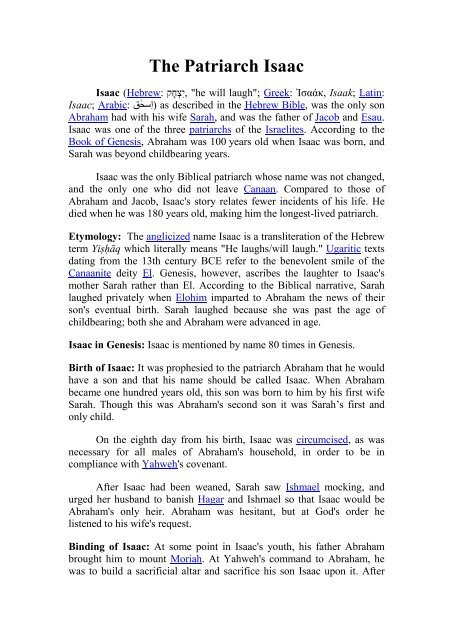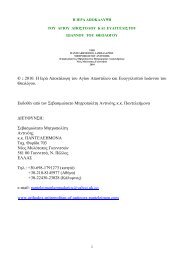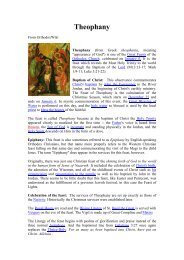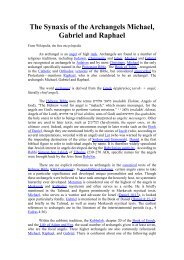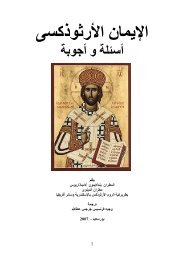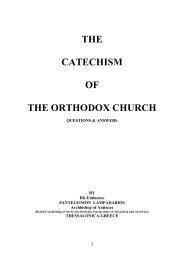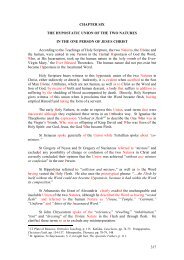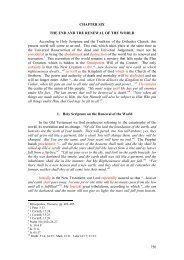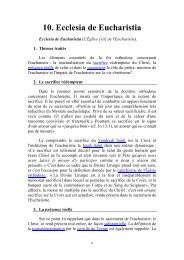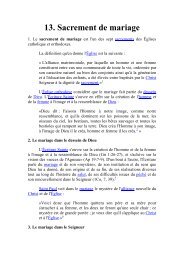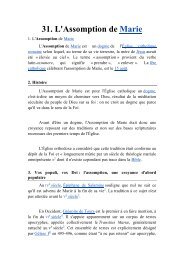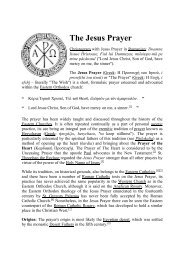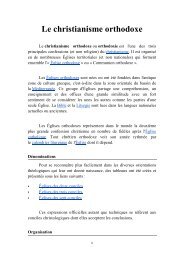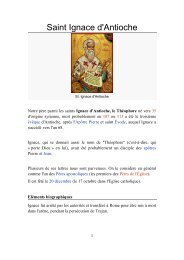The Patriarch Isaac - Orthodox-mitropolitan-of-antinoes-panteleimon ...
The Patriarch Isaac - Orthodox-mitropolitan-of-antinoes-panteleimon ...
The Patriarch Isaac - Orthodox-mitropolitan-of-antinoes-panteleimon ...
You also want an ePaper? Increase the reach of your titles
YUMPU automatically turns print PDFs into web optimized ePapers that Google loves.
<strong>The</strong> <strong>Patriarch</strong> <strong>Isaac</strong><strong>Isaac</strong> (Hebrew: ,יִצְחָק "he will laugh"; Greek: Ἰσαάκ, Isaak; Latin:<strong>Isaac</strong>; Arabic: إسحٰ ق ) as described in the Hebrew Bible, was the only sonAbraham had with his wife Sarah, and was the father <strong>of</strong> Jacob and Esau.<strong>Isaac</strong> was one <strong>of</strong> the three patriarchs <strong>of</strong> the Israelites. According to theBook <strong>of</strong> Genesis, Abraham was 100 years old when <strong>Isaac</strong> was born, andSarah was beyond childbearing years.<strong>Isaac</strong> was the only Biblical patriarch whose name was not changed,and the only one who did not leave Canaan. Compared to those <strong>of</strong>Abraham and Jacob, <strong>Isaac</strong>'s story relates fewer incidents <strong>of</strong> his life. Hedied when he was 180 years old, making him the longest-lived patriarch.Etymology: <strong>The</strong> anglicized name <strong>Isaac</strong> is a transliteration <strong>of</strong> the Hebrewterm Yiṣḥāq which literally means "He laughs/will laugh." Ugaritic textsdating from the 13th century BCE refer to the benevolent smile <strong>of</strong> theCanaanite deity El. Genesis, however, ascribes the laughter to <strong>Isaac</strong>'smother Sarah rather than El. According to the Biblical narrative, Sarahlaughed privately when Elohim imparted to Abraham the news <strong>of</strong> theirson's eventual birth. Sarah laughed because she was past the age <strong>of</strong>childbearing; both she and Abraham were advanced in age.<strong>Isaac</strong> in Genesis: <strong>Isaac</strong> is mentioned by name 80 times in Genesis.Birth <strong>of</strong> <strong>Isaac</strong>: It was prophesied to the patriarch Abraham that he wouldhave a son and that his name should be called <strong>Isaac</strong>. When Abrahambecame one hundred years old, this son was born to him by his first wifeSarah. Though this was Abraham's second son it was Sarah’s first andonly child.On the eighth day from his birth, <strong>Isaac</strong> was circumcised, as wasnecessary for all males <strong>of</strong> Abraham's household, in order to be incompliance with Yahweh's covenant.After <strong>Isaac</strong> had been weaned, Sarah saw Ishmael mocking, andurged her husband to banish Hagar and Ishmael so that <strong>Isaac</strong> would beAbraham's only heir. Abraham was hesitant, but at God's order helistened to his wife's request.Binding <strong>of</strong> <strong>Isaac</strong>: At some point in <strong>Isaac</strong>'s youth, his father Abrahambrought him to mount Moriah. At Yahweh's command to Abraham, hewas to build a sacrificial altar and sacrifice his son <strong>Isaac</strong> upon it. After
inding his son to the altar and drawing his knife to kill him, in the verylast moment an angel <strong>of</strong> Yahweh prevented Abraham from proceeding.Rather, he was directed to sacrifice a nearby ram instead. This eventserved as a test <strong>of</strong> Abraham's faith to Yahweh, not as an actual humansacrifice.Family life: When <strong>Isaac</strong> was 40, Abraham sent Eliezer, his steward, intoMesopotamia to find a wife for <strong>Isaac</strong>, from his nephew Bethuel's family.Eliezer chose Rebekah for <strong>Isaac</strong>. After many years <strong>of</strong> marriage to <strong>Isaac</strong>,Rebekah had still not given birth to a child and was believed to be barren.<strong>Isaac</strong> prayed for her and she conceived. Rebekah gave birth to twin boys,Esau and Jacob. <strong>Isaac</strong> was 60 years old when his two sons were born.<strong>Isaac</strong> favored Esau, and Rebekah favored Jacob.Occupation: Around the age <strong>of</strong> 75, <strong>Isaac</strong> moved to Beer-lahai-roi afterhis father died. When the land experienced famine, he removed to thePhilistine land <strong>of</strong> Gerar where his father once lived. This land was stillunder the control <strong>of</strong> King Abimelech as it was in the days <strong>of</strong> Abraham.Like his father, <strong>Isaac</strong> also deceived Abimelech about his wife and alsogot into the well business. He had gone back to all <strong>of</strong> the wells that hisfather dug and saw that they were all stopped up with earth. <strong>The</strong>Philistines did this after Abraham died. So, <strong>Isaac</strong> unearthed them andbegan to dig for more wells all the way to Beersheba, where he made apact with Abimelech, just like in the day <strong>of</strong> his father.Birthright: <strong>Isaac</strong> grew old and became blind. He called his son Esau anddirected him to procure some venison for him, in order to receive <strong>Isaac</strong>'sblessing. While Esau was hunting, Jacob deceptively, after listening to hismother's advice misrepresented himself as Esau to his blind father andobtained his father's blessing, making Jacob <strong>Isaac</strong>'s primary heir, andleaving Esau in an inferior position. <strong>Isaac</strong> sent Jacob into Mesopotamia totake a wife <strong>of</strong> his own family so, he can start a family <strong>of</strong> his own. After20 years working for Laban, Jacob returned home, and reconciled withhis twin brother Esau, then he and Esau buried <strong>Isaac</strong> when <strong>Isaac</strong> died atthe age <strong>of</strong> 180.Other references - <strong>Isaac</strong> in the New Testament: In the New Testament,there are references to <strong>Isaac</strong> having been "<strong>of</strong>fered up" by his father, andto his blessing his sons. Paul contrasted <strong>Isaac</strong>, symbolizing Christianliberty, with the rejected older son Ishmael, symbolizing slavery; Hagar isassociated with the Sinai covenant, while Sarah is associated with thecovenant <strong>of</strong> grace, into which her son <strong>Isaac</strong> enters. <strong>The</strong> Epistle <strong>of</strong> James
chapter 2, verses 21-24 states that the sacrifice <strong>of</strong> <strong>Isaac</strong> shows thatjustification (in the Johannine sense) requires both faith and works.In the early Christian church, Abraham's willingness to followGod's command to sacrifice <strong>Isaac</strong> was used as an example <strong>of</strong> faith and <strong>of</strong>obedience. <strong>The</strong> Epistle to the Hebrews chapter 11, verse 19 views therelease <strong>of</strong> <strong>Isaac</strong> from sacrifice as analogous to the resurrection <strong>of</strong> Jesus,the idea <strong>of</strong> the sacrifice <strong>of</strong> <strong>Isaac</strong> being a prefigure <strong>of</strong> the sacrifice <strong>of</strong> Jesuson the Cross.Testament <strong>of</strong> <strong>Isaac</strong>: <strong>The</strong> Testament <strong>of</strong> <strong>Isaac</strong> is a pseudonymous textwhich was most likely composed in Greek in Egypt after 100 CE. It isalso dependent on the Testament <strong>of</strong> Abraham. In this testament, Godsends the archangel Michael to <strong>Isaac</strong> in order to inform him <strong>of</strong> hisimpending death. <strong>Isaac</strong> accepts God's decree but Jacob resists. <strong>Isaac</strong> in hisbed-chamber tells Jacob <strong>of</strong> the inevitability <strong>of</strong> death. <strong>Isaac</strong> has a tour <strong>of</strong>heaven and hell shortly before his death in which God's compassion torepentant sinners is emphasized. In this testament, <strong>Isaac</strong> also talks withthe crowds on the subjects <strong>of</strong> priesthood, asceticism, and the moral life.World views: <strong>The</strong> early Christian church viewed Abraham's willingnessto follow God's command to sacrifice <strong>Isaac</strong> as an example <strong>of</strong> faith andobedience. For Christians, Abraham's willingness to sacrifice his son is a"type and shadow" <strong>of</strong> God's willingness to sacrifice his only son, Jesus.Some academic scholars have described <strong>Isaac</strong> as "a legendaryfigure", while others view him as "a figure representing tribal history,though as a historical individual" or as "a seminomadic leader".Documentary hypothesis: <strong>The</strong> name <strong>Isaac</strong> occurs 32 times in theHebrew Bible. Variations <strong>of</strong> the formula "Abraham, <strong>Isaac</strong>, and Jacob"occur 23 times in the Hebrew Bible. According to the documentaryhypothesis, use <strong>of</strong> names <strong>of</strong> God indicates authorship, and form criticsvariously assign passages like Genesis chapter 26, verses 6-11 to theYahwist source, and Genesis chapter 20 verses 1-7, chapter 21, verse 1 tochapter 22, verse 14 and chapter 22, verse 19 to the Elohist source; thissource-critical approach has admitted problems, in that the name"Yahweh" appears in Elohist material. According to the compilationhypothesis, the formulaic use <strong>of</strong> the word toledoth (generations) indicatesthat Genesis chapter 11, verse 27 to chapter 25, verse 19 is <strong>Isaac</strong>'s recordthrough Abraham's death (with Ishmael's record appended), and Genesischapter 25, verse 19 to chapter 37, verse 2 is Jacob's record through<strong>Isaac</strong>'s death (with Esau's records appended).
Jewish views: In rabbinical tradition the age <strong>of</strong> <strong>Isaac</strong> at the time <strong>of</strong>binding is taken to be 37 which contrasts with common portrayals <strong>of</strong><strong>Isaac</strong> as a child. <strong>The</strong> rabbis also thought that the reason for the death <strong>of</strong>Sarah was the news <strong>of</strong> the intended sacrifice <strong>of</strong> <strong>Isaac</strong>. <strong>The</strong> sacrifice <strong>of</strong><strong>Isaac</strong> is cited in appeals for the mercy <strong>of</strong> God in later Jewish traditions.<strong>The</strong> post-Biblical Jewish interpretations <strong>of</strong>ten elaborate the role <strong>of</strong> <strong>Isaac</strong>beyond the Biblical description and largely focus on Abraham's intendedsacrifice <strong>of</strong> <strong>Isaac</strong>, called the aqedah ("binding"). According to a version<strong>of</strong> these interpretations, <strong>Isaac</strong> died in the sacrifice and was revived.According to many accounts <strong>of</strong> Aggadah, unlike the Bible, it is Satanwho is testing <strong>Isaac</strong> and not God. <strong>Isaac</strong>'s willingness to follow God'scommand at the cost <strong>of</strong> his death has been a model for many Jews whopreferred martyrdom to violation <strong>of</strong> the Jewish law.According to the Jewish tradition <strong>Isaac</strong> instituted the afternoonprayer. This tradition is based on Genesis chapter 24, verse 63 ("<strong>Isaac</strong>went out to meditate in the field at the eventide").<strong>Isaac</strong> was the only patriarch who stayed in Canaan during hiswhole life and though once he tried to leave, God told him not to do so.Rabbinic tradition gave the explanation that <strong>Isaac</strong> was almost sacrificedand anything dedicated as a sacrifice may not leave the Land <strong>of</strong> Israel.<strong>Isaac</strong> was the oldest <strong>of</strong> the Biblical patriarchs at the time <strong>of</strong> his death, andthe only patriarch whose name was not changed.Rabbinic literature also linked <strong>Isaac</strong>'s blindness in old age, as statedin the Bible, to the sacrificial binding: <strong>Isaac</strong>'s eyes went blind because thetears <strong>of</strong> angels present at the time <strong>of</strong> his sacrifice fell on <strong>Isaac</strong>'s eyes.Western scholarly views: Some scholars have described <strong>Isaac</strong> as "alegendary figure" while others view him "as a figure representing tribalhistory, though as a historical individual" or "as a seminomadic leader."<strong>The</strong> stories <strong>of</strong> <strong>Isaac</strong>, like other patriarchal stories <strong>of</strong> Genesis, aregenerally believed in liberal Western scholarship to have "their origin infolk memories and oral traditions <strong>of</strong> the early Hebrew pastoralistexperience." Conservative Western scholarship believes the stories <strong>of</strong><strong>Isaac</strong>, and other patriarchal stories in Genesis, to be factual. <strong>The</strong>Cambridge Companion to the Bible makes the following comment on theBiblical stories <strong>of</strong> the patriarchs:Yet for all that these stories maintain a distance between theirworld and that <strong>of</strong> their time <strong>of</strong> literary growth and composition, theyreflect the political realities <strong>of</strong> the later periods. Many <strong>of</strong> the narratives
deal with the relationship between the ancestors and peoples who werepart <strong>of</strong> Israel’s political world at the time the stories began to be writtendown (eighth century B.C.E.). Lot is the ancestor <strong>of</strong> the Transjordanianpeoples <strong>of</strong> Ammon and Moab, and Ishmael personifies the nomadicpeoples known to have inhabited north Arabia, although located in theOld Testament in the Negev. Esau personifies Edom (36:1), and Labanrepresents the Aramean states to Israel’s north. A persistent theme is that<strong>of</strong> difference between the ancestors and the indigenous Canaanites… Infact, the theme <strong>of</strong> the differences between Judah and Israel, as personifiedby the ancestors, and the neighboring peoples <strong>of</strong> the time <strong>of</strong> the monarchyis pressed effectively into theological service to articulate the choosing byGod <strong>of</strong> Judah and Israel to bring blessing to all peoples.”According to Martin Noth, a scholar <strong>of</strong> the Hebrew Bible, thenarratives <strong>of</strong> <strong>Isaac</strong> date back to an older cultural stage than that <strong>of</strong> theWest-Jordanian Jacob. At that era, the Israelite tribes were not yetsedentary. In the course <strong>of</strong> looking for grazing areas, they had come incontact in southern Palestine with the inhabitants <strong>of</strong> the settledcountryside. <strong>The</strong> Biblical historian, A. Jopsen, believes in the connectionbetween the <strong>Isaac</strong> traditions and the north and in support <strong>of</strong> this theoryadduces Amos 7:9 ("the high places <strong>of</strong> <strong>Isaac</strong>").Albrecht Alt and Martin Noth hold that, "<strong>The</strong> figure <strong>of</strong> <strong>Isaac</strong> wasenhanced when the theme <strong>of</strong> promise, previously bound to the cults <strong>of</strong> the'God the Fathers' was incorporated into the Israelite creed during thesouthern-Palestinian stage <strong>of</strong> the growth <strong>of</strong> the Pentateuch tradition."According to Martin Noth, at the Southern Palestinian stage <strong>of</strong> the growth<strong>of</strong> the Pentateuch tradition, <strong>Isaac</strong> became established as one <strong>of</strong> theBiblical patriarchs, but his traditions were receded in the favor <strong>of</strong>Abraham.


